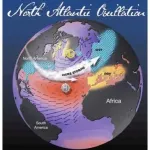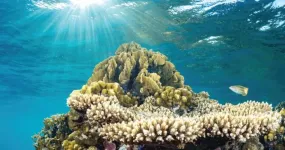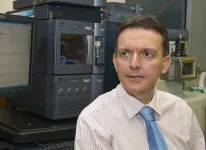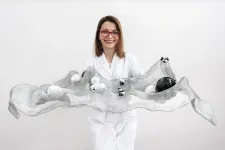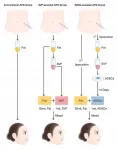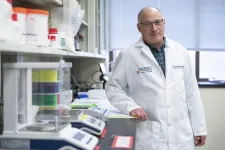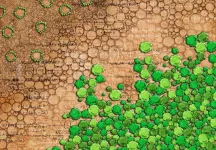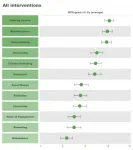Scientists find Galapagos volcano could help forecast future eruptions
Findings capture a new level of detail for any eruption from a volcano on the islands
2021-04-19
(Press-News.org) MIAMI--The Galápagos Islands have played a historic role since Charles Darwin's visit onboard the HMS Beagle in 1835. Today, a team of scientists, including from the University of Miami (UM) Rosenstiel School of Marine and Atmospheric Science, studied a large eruption in the archipelago to get new insights into how volcanoes behave and could help forecast future events.
The study gives the first detailed description of a volcanic eruption from Sierra Negra found on Isla Isabela - the largest of the Galápagos Islands and home to nearly 2,000 people.
The findings, published in Nature Communications, reveal how the volcano inflated and fractured before it erupted and captures a new level of detail for any eruption from a volcano on the islands.
Networks of ground-based seismic and GPS monitoring stations, and satellites, captured data for 13 years before Sierra Negra's eruption, in June 2018.
The surface of the volcano rose during this time, indicating a gradual accumulation of molten rock - known as magma - found in a reservoir under the volcano. The signals were among the largest ever recorded at a volcano of this type, experts say.
The Galápagos Islands' remote location, in the Pacific Ocean, about 1000 kilometers off the Ecuadorian coast, means there were big gaps in scientists' understanding of the volcanic processes that formed them and control their activity.
This eruption provided a rare opportunity to fill some of the gaps, researchers say. An international team integrated geophysical data with analysis of the chemical composition of the erupted lava. They were supported in doing so by the Parque Nacional Galápagos.
"The run-up to the eruption was very exciting," said Falk Amelung, a professor of marine geosciences at the UM Rosenstiel School and a coauthor of the study. "Half-a-year earlier we saw from our satellite data that the caldera floor was uplifting at a rate of 10 centimeters a month. Such high inflation rates are rarely seen at active volcanoes."
Sierra Negra's eruption continued for nearly two months, spurting out lava flows which extended 10 miles to the island's coast. Fresh earthquakes accompanied the eruption and emptying of the magma reservoir.
After the eruption, the hills within a six-mile wide hollow at the summit of the volcano - known as a caldera - were nearly two meters higher. This phenomenon, known as caldera resurgence, is important for understanding when and where eruptions happen, scientists say. However, it is rare and has never been observed to this extent before.
The team also discovered that the ascending magma permanently uplifted what they call a 'trapdoor' in the floor of the caldera. This raised its surface and, in a complex interplay, triggered large earthquakes that led to the eruption.
The 2018 eruption was a stark reminder of the potential threat to life, livelihoods, and the iconic wildlife of the Galápagos - including the slow-moving giant tortoise and land iguana - the researchers said.
This new understanding of volcano behavior will allow local scientists to track the evolution of volcanic unrest before future eruptions and communicate warnings to local authorities and the public.
"The 2018 eruption of Sierra Negra was a really spectacular volcanic event, occurring in the 'living laboratory' of the Galápagos Islands," said Andrew Bell from the University of Edinburgh's School of GeoSciences who led the research.
"Great teamwork, and a bit of luck, allowed us to capture this unique dataset that provide us with important new understanding as to how these volcanoes behave, and how we might be able to better forecast future eruptions."
The Galápagos' Isla Isabela is also the destination of the UM Rosenstiel School's UGalapagos Study Abroad program, which Sierra Negra volcano being one of several geological field trips where students got an opportunity to see first-hand a volcano showing signs of significant unrest.
INFORMATION:
The research team would like to thank the Instituto Geofísico, Parque Nacional Galápagos, and Charles Darwin Foundation for their support with fieldwork in the Galápagos. The study was funded by Natural Environment Research Council and the National Science Foundation.
-- Adapted from the University of Edinburgh news release
About the University of Miami's Rosenstiel School
The University of Miami is one of the largest private research institutions in the southeastern United States. The University's mission is to provide quality education, attract and retain outstanding students, support the faculty and their research, and build an endowment for University initiatives. Founded in the 1940's, the Rosenstiel School of Marine & Atmospheric Science has grown into one of the world's premier marine and atmospheric research institutions. Offering dynamic interdisciplinary academics, the Rosenstiel School is dedicated to helping communities to better understand the planet, participating in the establishment of environmental policies, and aiding in the improvement of society and quality of life. For more information, visit: http://www.rsmas.miami.edu and Twitter @UMiamiRSMAS
[Attachments] See images for this press release:
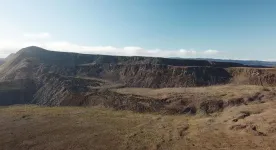
ELSE PRESS RELEASES FROM THIS DATE:
2021-04-19
MIAMI--A new study led by scientists at the University of Miami (UM) Rosenstiel School of Marine and Atmospheric Science provides evidence that humans are influencing wind and weather patterns across the eastern United States and western Europe by releasing CO2 and other pollutants into Earth's atmosphere.
In the new paper, published in the journal npj Climate and Atmospheric Science, the research team found that changes in the last 50 years to an important weather phenomenon in the North Atlantic--known as the North Atlantic Oscillation--can be traced back to human activities that impact the climate system.
"Scientists have long understood that human actions are warming the planet," said the study's lead author Jeremy ...
2021-04-19
The results of coral beaching are obvious -- stark underwater forests of white coral skeletons -- yet the physiological processes of bleaching are not well understood. Now, KAUST researchers show that, long before signs of bleaching appear, prolonged spells of warm water cause heat stress that disrupts the nutrient cycling of the coral and its symbiotic algae.
Coral reefs occur in warm low-nutrient waters. Stony corals include the coral animal, which is a cnidarian host that lives in symbiosis with Symbiodiniaceae, single-celled algae that photosynthesize to help "feed" the coral in exchange for the ...
2021-04-19
Varying severity of COVID-19 symptoms in patients is reflected by levels of a chemical biomarker in their body which scientists say could be used to better manage treatments and other interventions, including vaccinations.
In a new paper in International Journal of Infectious Diseases, medical experts in Italy and Australia examined levels of a chemical called serum amyloid A (SAA), a protein synthesised in the liver which can spike up to 1,000-fold within the first 24-48 hours of an infection.
In turn, an increase in SAA can further perpetuate inflammation and cause clot abnormalities and organ damage, researchers say, concluding SAA levels are associated ...
2021-04-19
Solid-matrix catalysts called heterogeneous catalysts are among the most widespread industrial applications in reducing toxic gases, unburned fuel, and particulate matter in the exhaust stream from the combustion chamber. They are also used in energy, chemical, and pharmaceutical sectors, i.e., production of biodiesel, polymers, biomass/waste conversion into valuable products, and many others processes. All thanks to their active sites and high surface. Nevertheless, their high efficiency is limited by the astronomic price of noble metals, So, cost-effective substitutes with comparable effectivity seem to be a holy grail for the industry. A recent paper ...
2021-04-19
OSAKA, Japan. Look at any piece of machinery and you will see a complex network of moving parts, or actuators, each with its own function, all working together for a common goal. From this perspective, the way most machines differ is in the way their actuators are powered: excavators rely on compressed liquid (hydraulic), the brake system in a car uses compressed air (pneumatic), and a printer has electricity.
What if the moving parts of a machine could be powered by light? A machine made up of photoactuators would not need direct contact with the power source to move. Among its many ...
2021-04-19
Durham, NC - A study released today in STEM CELLS Translational Medicine suggests a new way to correct facial atrophy of localized scleroderma (LoS) in patients. It shows how applying grafts made up of the patient's own fat enhanced with adipose?derived stem cells (ADSCs) is a safe, feasible and attractive alternative to conventional fat grafting or fat grafting combined with stromal vascular fraction in treating this condition.
LoS is a rare autoimmune disease caused when the body makes too much collagen, which results in the skin becoming stiff and hard. "Presenting mainly as subcutaneous tissue atrophy and hyperpigmentation, this disorder seriously ...
2021-04-19
A COVID-19 vaccine that could provide protection against existing and future strains of the COVID-19 coronavirus, and other coronaviruses, and cost about $1 a dose has shown promising results in early animal testing.
Vaccines created by UVA Health's Steven L. Zeichner, MD, PhD, and Virginia Tech's Xiang-Jin Meng, MD, PhD, prevented pigs from being becoming ill with a pig model coronavirus, porcine epidemic diarrhea virus (PEDV). The vaccine was developed using an innovative approach that Zeichner says might one day open the door to a universal vaccine for coronaviruses, ...
2021-04-19
A new study from the UBC Sauder School of Business finds a subtle shift in organ donor messaging can lead to a big boost in registration.
Organ donation saves countless lives every year, and most people think it's the right thing to do -- but when it comes to people actually registering to donate, the numbers around the world are surprisingly low. This is particularly so in countries that rely on informed consent and require people to learn about organ donation before they opt-in to register as a donor.
In fact, in Canada, just 32 per cent of people have registered to become organ donors.
Transplant agencies have tried a range of strategies to increase donation levels, including the introduction of in-hospital organ donation coordinators, greater public ...
2021-04-19
A forest looks like a hotbed of randomness, with trees and plants scattered in wild and capricious diversity. But appearances can be deceiving, say a trio of complexity researchers at the Santa Fe Institute (SFI). Underneath that apparent messiness lurk extraordinary regularities, governed by the biological mechanisms that drive universal forces of growth, death, and competition.
In a paper published April 9 in the journal PNAS, the SFI group, led by Program Postdoctoral Fellow and now Complexity Science Hub Vienna Postdoctoral Scientist Eddie Lee, describes a new framework that can reproduce those spatial and temporal patterns that emerge in places and ...
2021-04-19
The internet seems like the place to go to get into fights. Whether they're with a family member or a complete stranger, these arguments have the potential to destroy important relationships and consume a lot of emotional energy.
Researchers at the University of Washington worked with almost 260 people to understand these disagreements and to develop potential design interventions that could make these discussions more productive and centered around relationship-building. The team published these findings this April in the latest issue of the Proceedings of the ACM in Human Computer Interaction Computer-Supported Cooperative Work.
"Despite the fact that online spaces are often described as toxic and polarizing, ...
LAST 30 PRESS RELEASES:
[Press-News.org] Scientists find Galapagos volcano could help forecast future eruptions
Findings capture a new level of detail for any eruption from a volcano on the islands

